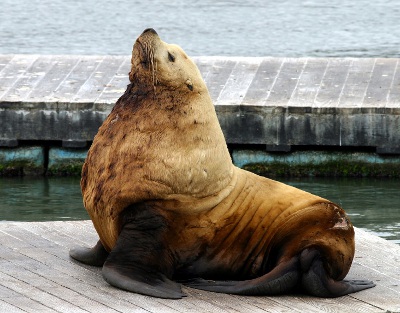Northern Sea Lion
Category: North American Mammals

Facts about Northern Sea Lion, "Scientific name for Northern Sea Lion is Emetopias jubatus". Northern Sea Lion is a Eumetopias type of sea animal that belongs to the Otariidae family. The Northern Sea Lion are native to the northern Pacific, and they are also called as the Steller sea lion and Steller's sea lion. The Northern Sea Lion is the only variety of the genus Eumetopias, and it is the biggest of the eared seals. The Northern Sea Lion has attracted substantial attention in current decades because of considerable, mysterious declines in their population over a large part of their variety in Alaska. The Northern Sea Lion are largely found in water bodies throughout the world, but they cannot be seen in the Northern Atlantic Ocean. The Northern Sea Lion is measured to be a Pinniped, which signifies that it has a winged foot. They are also categorized as sea animals.
Features of Northern Sea Lions
The Northern Sea Lion is a large-sized sea animal, with a pale yellow to tawny color body. The male Northern Sea Lions are somewhat longer than the females, with a body length, ranging from 9 feet 3 inches (2.8 meters) to 10 feet 7 inches (3.2 meters), whereas the females have a body length between 7 feet 5 inches (2.2 meters) and 9 feet 5 inches(2.8 meters). The male Northern Sea Lions contain much broader necks, chests, and general front body structure and are heavier than the females, with a body mass that ranges from 990 pounds (449 kg) to 2,470 pounds (1120 kg), whereas the females weigh between 530 pounds (240 kg) and 770 pounds (349 kg).
A male Northern Sea Lion continues to grow pending the appearance of their minor sexual attributes during their 5th to 8th year. The bigger body size of the males assists them to gain the skill to mate with females because the females will search for the biggest males available to be with. A male Northern Sea Lion is further differentiated from a female lion by wider, elevated foreheads, flatter nose, and darker, somewhat tufted hair around their huge necks, offering them a maned look.
The male Northern Sea Lion is called a bull and the female is called a cow. Their children are called as pups. A huge group of Sea Lions is called as a pod or a colony. Northern Sea Lions are habitually found in very big colonies. Intended for their safety, they will stay extremely close together both in the water and on land. The huge colonies also contain several subgroups found among them. It is universal for a Northern Sea Lion to shift from one subgroup to another during different stages of its life. They prefer to live in extremely close groups, although habitually they have an abundance of space to spread out more.
Diet of Northern Sea Lion
A Northern Sea Lion is a carnivorous sea animal, which indicates that they adore consuming meat. Their staple food is fish, but they enjoy feeding on squid that is frequently found in the water. When this sea animal finds food to consume, it will ingest it devoid of chewing it up.
Behavior of Northern Sea Lion
Northern Sea Lions are considered to be extremely clever animals. They have been exercised to educate tricks for amusement. They have also been educated to assist the United States Navy by means of their in-water requirements. For the major part, they are measured to be extremely timid, but they will also sometimes carry out violent attacks on humans. The male Northern Sea Lions are extremely violent when the situation comes to earning the exact to mate with female lions.
Reproduction of Northern Sea Lion
Reproductively grown-up male Northern Sea Lions assemble in May on conventional, well-clear reproductive rookeries, generally on seashores on remote islands. The bigger, older male lions establish and protect different territories on the rookery. After a week or so, adult female lions arrive, accompanied rarely by sexually young offspring, and form liquid aggregations all through the rookery. Northern Sea Lion pups are born with a black-colored body, with the body mass of 51 pounds (23 kg), and they remain dark for many months. Males and females both grow swiftly until the 5th year, after which the female growth slows significantly. As soon as the pups are one year old, they are also inclined to form petite subgroups.
A male Northern Sea Lion lives up to 18 years, whereas the female lion will live up to 30 years.

 Back To Category North American Mammals
Back To Category North American Mammals